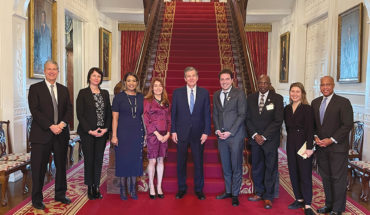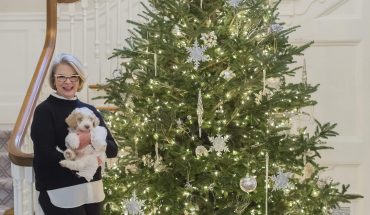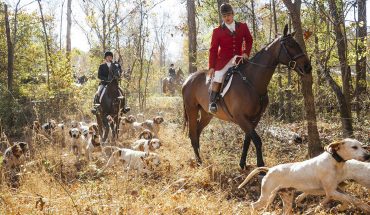by Liza Roberts
photographs by Nick Pironio
Meg Lowman believes in a lot of things: The sanctity of the treetops. The importance of insects, curiosity, resilience, and adventure. She believes in “no child left indoors” and “the power of one.” And kismet. “I find that I find myself at the right place at the right time,” the pioneering treetop ecologist says as she takes a brisk walk around Raleigh’s Lake Johnson one recent afternoon. “A lot of things just happen by fate.”
Maybe. But Lowman, 59, didn’t become “Canopy Meg,” the vanguard-setter for an entire science, and the founding director of the N.C. Nature Research Center, without more than luck on her side. “The Einstein of the treetops,” as The Wall Street Journal dubbed her, is also a successful author, one who has helped invent new mechanisms to explore the canopy’s “eighth continent” and popularized the very idea of venturing up high to learn more about what’s happening down below.
Her enthusiasm is clearly a major factor. It spills over, uncontained by the petite vessel of her physical self. She gestures high, up to the lakefront’s sun-dazzled trees, to demonstrate how she taught herself to use a slingshot to shoot a climbing rope into the highest boughs of the Australian rainforest, back when she climbed her first tree as a scientist in 1979. She’s exuberant no matter the audience. At the Natural Sciences Museum’s Prairie Ridge Ecostation, Lowman takes a bug-suction bottle she’s wearing like a necklace and hands it to a child, who quickly sucks a tiny sweat bee up from a leaf and into the jar. “That’s fantastic!” She’s giddy. “Wonderful, wonderful!”
Lowman is “a gifted communicator,” says Brian Rosborough, the founding chairman of Earthwatch Institute, who has known her since 1980, when his group funded some of her initial canopy research. “She’s able to reach young and old about the complexities of life.” It doesn’t hurt to have the glee of a child, and with Lowman’s blonde bob, drawstring khakis, many-pocketed fly-fishing vest, red-white-and-blue Nike sneakers, and scorpion necklace, Lowman has the cool and colorful attire of one, too. “It’s a handsome little beetle!” she cries, seeing another discovery.
She shows a group of kids how to “sweep-net” for bugs in order to count them accurately. It’s not a small matter; it’s a chunk of her life’s work over the past 30 years, logging biodiversity, then working on its conservation. “These important little things that run the earth” is what she calls insects; “the glue of the ecosystem.” But the ones down here on the ground are not her main priority. Instead, the insects in the vast expanse of the planet’s treetop canopy command her attention. It’s largely thanks to her that we now know more than half of the planet’s biodiversity lives in trees, and, thanks to efforts she has championed, that chunks of it are being preserved.
Lowman has had to use her ingenuity to make it happen: She has created scaffold-like, treehouse-inspired walkways to document the critters and plants up there; dangled from cranes to expand her range; floated in leaf-skimming hot-air balloons and sled-dragging dirigibles to surf the tips of trees on five continents. Meeting for lunch at the Nature Research Center’s Daily Planet Café not long ago, her feet had only recently landed back on terra firma – down from the forests of both Ethiopia and Bald Head Island.
Her role at the $56-million NRC, which opened last year, is as broad as her research: Initially its director, she now serves as the NRC’s senior scientist, the public face of the museum, and its ambassador to the scientific community. The change comes as the NRC integrates into the larger Museum of Natural Sciences, and Lowman says it reflects the real focus of her work: Active research, conservation, education, university partnerships, and communication with the public. International forays like her annual trips to the Amazon continue apace, and the groups of “citizen scientists” she leads there often help her research, she says.

Meg Lowman speaks with children, Julia Hughes 9, Kolton Vannoy 9, Sam Hughes 5 and Kayla Vannoy 10 at the Natural History Museum. Mothers Angie Vannoy and Keri Hughes all from Fuquay.
Lowman “has the rare ability to lead children, adolescents, and world-renowned scientists and leaders seamlessly,” says Kristin Replogle, who serves on the Citizen Science Council board of directors of the NRC, and who has accompanied Lowman to the Amazon with her family of six. “She is truly a talented pioneer in the science of canopy ecology, and a gifted leader.”
In the NRC’s biodiversity lab another day, Lowman leads a group of college and graduate students excited to be working with their hero. Together they discuss plans to take a group of visiting “mobility-limited” students ¬– most use wheelchairs – into the treetops to study the canopy. This is not a daunting concept to Lowman; it just requires planning.
“She’s always energetic, and always selfless,” says Kelly Nickodem, a graduate student in geography at Syracuse University who is Lowman’s intern for the summer. “She always makes me think.”
Home base
“I love, love, love, love Raleigh,” Lowman says. “The only thing missing is my husband.” Her husband, Michael Brown, has so far stayed behind in their condo overlooking the mangrove trees of Sarasota, Fla., for his job as a lawyer. Lowman left her job there as professor and director of environmental initiatives at New College of Florida to launch the NRC.
“Here’s my own urban ecosystem,” Lowman says, welcoming a visitor into her ninth-floor Raleigh apartment a few blocks from the museum. The view is panoramic, and the coincidence is not lost on her that the main thing one sees from her wide windows is not mangroves, but treetops all the same.
“Raleigh is so green, I can’t help but gasp when I look out my window,” she says. Others might gasp when they look at what’s inside.
Glass-domed, preserved scorpions and tarantulas. A porcupine made from a gourd; a piranha made of bark. A display of Amazonian blowguns as tall as the wall. “I can’t live without my blowguns,” she says. A wooden inlay of a tiger from Bangalore; a tarantula puppet; a small carved rhino: “There’s so much wonder in how other cultures turn things into art,” she says, “but here’s my best artwork.” She points to two framed paintings in the style of Picasso’s Blue Period. They are the kind of childhood art that amazes – most households have an example or two – made by each of her sons when they were small. Today, Eddie and James are in their 20s, and both scientists.
Lowman chronicled their adventurous younger years in Life in the Treetops, the book she wrote in 1999 that tells an honest story of the struggle to combine motherhood with a demanding scientific career. It was named a New York Times notable book of the year, heralded for telling hard truths few had broached in the field of science. “I’m a mom first, and a scientist second,” she says, and that’s clear in this detailed accounting of the years when her sons were small, gamely joining their mother for rainforest adventures.
“I should have gone to a shrink, but I wrote a book instead,” she jokes. She credits her love of science with getting her through: “You follow your passion and doggedly drown in work.” Her struggle involved more than the usual maternal juggling act: She also extricated herself from a foreign culture and a dysfunctional first marriage along the way.
Early passion
Like many people with a consuming passion, Lowman’s started early. As a child in Elmira, N.Y., “there was nothing to do,” she says. “So a lot of what I did was make tree forts with my best friend Betsy. We did all of the classic stuff: Band-Aided earthworms, saved birds who fell out of trees, kept bugs in boxes.”
Betsy (who this summer will help run the Meg Lowman Treetop Camp for underprivileged girls in Elmira), went on to become a nurse; Betsy’s brother, who stayed indoors sewing jeans, went on to become Tommy Hilfiger. The red-white-and-blue Nikes Lowman wears most days are a gift from him, and Hilfiger’s support extends to the NRC itself, where he serves on the Citizen Science Council.
“I think we’re the only ones who left Elmira,” Lowman jokes. And like her fashion-mogul friend, when Lowman left Elmira, boy, did she leave Elmira.
After graduating from Williams College, a master’s degree program in Scotland ended up changing her life. A professor’s comment did it: “He said, ‘You’re a nobody if you don’t go to the tropics. That’s where all of the unknowns remain.’” And so she found a PhD program in Sydney, Australia, and began to study the rainforest.
When she wanted to get up into the trees there, she had to improvise. She didn’t know how to climb, so she asked students in the cave-exploring club to teach her (she figured climbing up couldn’t be that different from climbing down); made herself a harness, and bought herself some rope. Her aim was to count leaves, and to find out how long they lived. She marked them with waterproof pens, and came back periodically to count and log their growth. But bugs got in the way: “I didn’t plan to study insects, but they were eating my gosh-darned leaves! It actually made it a lot more fun.”
Then things took another turn: Lowman married a sheep and cattle rancher, moved to his remote, 5,000-acre sheep station in the Outback, and her boys were born. Suddenly, she was a “moonlight scientist,” prohibited by cultural expectations as a wife and mother from properly “working,” but fitting in fieldwork whenever and however she could.
It was not a happy time, she will tell you. So when a call came from Williams, asking her to teach a course as a visiting professor, she jumped at the chance, taking the kids, and, as it turned out, never looking back. A “telephone divorce” followed, and then she became “the happiest single mom in the whole U.S. of A.
“I owe my life to my boys,” she says. “They are the most flexible, enthusiastic, wonderful people.”
Everyday discoveries
As she turns away from her boys’ childhood artwork and heads out the door of the apartment, Lowman bends down to pluck something from a basket on the floor: a small vial of alcohol, with a beetle floating inside. “This is a new species that my children and I found!” she says, as if that’s not astonishing. “It was eating a bromeliad.”
The interaction of plants and insects is the crux of Lowman’s work. When you study the plants that bugs eat, you learn about the properties of both. When you study the plants that are resistant to bugs, you learn about the toxins they produce to keep them away – toxins that often have medicinal properties.
“Shamans turn them into medicine,” she says. “So I hang out with a lot of shamans.” She shows a collection of potions they’ve given her. “This is the apothecary that comes from the canopy,” she says. “That has to make you love insects a little more.” She’s got aids for ailments including impotence, arthritis, and baldness. “I’ve never seen an Amazonian who is bald!” She laughs. Shamans make a living off of understanding their environment, and Lowman has come to believe that economics are at the heart of science’s new frontier, and of her own.
“I see myself having a second chapter, all about the economics of the environment. What does it mean economically if you lose your freshwater spring or pollution creates asthma in your community? We need to make an economic case for preserving the environment. It’s the most realistic way to get things done.” It’s a practical mindset born of a passionate purpose.
“She has always been deeply concerned with what’s happening to the earth,” says her very first tree-climbing buddy, Betsy Hilfiger, or “Hullabaloo,” as Meg calls her, after the name the two gave their first tree fort.
“Most of us live day-to-day, but Meg is passionate about the future of mother nature, and about the future of others,” Hilfiger says. “And that makes her a very special person.”





